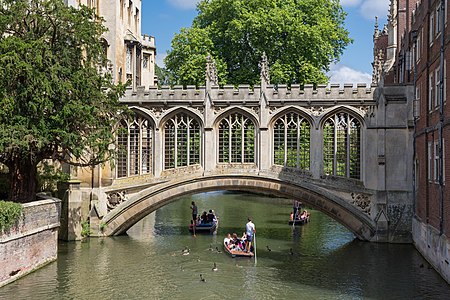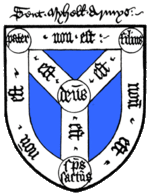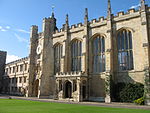Bridge of Sighs, Cambridge
Bridges across the River CamBridges completed in 1831Bridges in CambridgeBuildings and structures of the University of CambridgeCovered bridges in England ... and 7 more
Grade I listed bridgesGrade I listed buildings in CambridgePedestrian bridges in EnglandSt John's College, CambridgeUnited Kingdom bridge (structure) stubsUniversity of Cambridge stubsUse British English from February 2017

The Bridge of Sighs in Cambridge, England is a stone covered bridge at St John's College, Cambridge. It was built in 1831 and crosses the River Cam between the college's Third Court and New Court. The architect was Henry Hutchinson. It is named after the Bridge of Sighs in Venice, although they have little architecturally in common beyond the fact that they are both covered bridges with arched bases. The bridge, a Grade I listed building, is a Cambridge attraction and Queen Victoria is said to have loved it more than any other spot in the city.
Excerpt from the Wikipedia article Bridge of Sighs, Cambridge (License: CC BY-SA 3.0, Authors, Images).Bridge of Sighs, Cambridge
Bridge of Sighs, Cambridge Newnham
Geographical coordinates (GPS) Address External links Nearby Places Show on map
Geographical coordinates (GPS)
| Latitude | Longitude |
|---|---|
| N 52.208425 ° | E 0.11576666666667 ° |
Address
Bridge of Sighs
Bridge of Sighs
CB2 1TP Cambridge, Newnham
England, United Kingdom
Open on Google Maps










